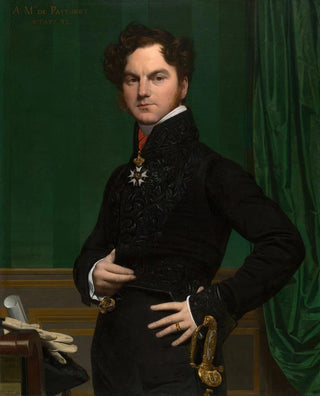Art print | Amédée-David le comte de Pastoret - Jean-Auguste-Dominique Ingres


View from behind

Frame (optional)
In the rich and captivating universe of French academic painting, the art print "Amédée-David le comte de Pastoret" by Jean Auguste Dominique Ingres stands out for its depth and elegance. This depiction of the count of Pastoret, a man of letters and politician, not only showcases Ingres's undeniable talent but also his skill in capturing the very essence of his subjects. The art print Amédée-David le comte de Pastoret - Jean Auguste Dominique Ingres immerses us in an atmosphere where realism and refinement coexist, offering a window into a bygone era when art harmoniously intertwined with intellectual and social life.
Style and uniqueness of the work
The piece is characterized by a neoclassical style, marked by a rigor and precision that are Ingres's signature. The treatment of drapery, the finesse of the lines, and the use of light give this painting an almost sculptural dimension. The colors, subtle and nuanced, create a serene ambiance, while the penetrating gaze of the count of Pastoret seems to engage the viewer, inviting reflection on the values of his time. Ingres manages to transcend mere representation to offer a reflection on identity and human dignity. Every detail, from the costume to the posture, is carefully thought out to reveal the personality of the model, making this work a true masterpiece of portraiture.
The artist and his influence
Jean Auguste Dominique Ingres, an emblematic figure of the 19th century, knew how to mark his era with his unique approach to painting. A student of Jacques-Louis David, he mastered the principles of neoclassicism while infusing his own vision. Ingres was always fascinated by ideal beauty and the harmony of forms, which is reflected in his portraits and historical compositions. His influence extends far beyond his time, inspiring many artists who sought to capture beauty with the same intensity. Through his works, he redefined the standards of academic painting, laying the foundations for a new artistic sensibility that flourished

Matte finish

View from behind

Frame (optional)
In the rich and captivating universe of French academic painting, the art print "Amédée-David le comte de Pastoret" by Jean Auguste Dominique Ingres stands out for its depth and elegance. This depiction of the count of Pastoret, a man of letters and politician, not only showcases Ingres's undeniable talent but also his skill in capturing the very essence of his subjects. The art print Amédée-David le comte de Pastoret - Jean Auguste Dominique Ingres immerses us in an atmosphere where realism and refinement coexist, offering a window into a bygone era when art harmoniously intertwined with intellectual and social life.
Style and uniqueness of the work
The piece is characterized by a neoclassical style, marked by a rigor and precision that are Ingres's signature. The treatment of drapery, the finesse of the lines, and the use of light give this painting an almost sculptural dimension. The colors, subtle and nuanced, create a serene ambiance, while the penetrating gaze of the count of Pastoret seems to engage the viewer, inviting reflection on the values of his time. Ingres manages to transcend mere representation to offer a reflection on identity and human dignity. Every detail, from the costume to the posture, is carefully thought out to reveal the personality of the model, making this work a true masterpiece of portraiture.
The artist and his influence
Jean Auguste Dominique Ingres, an emblematic figure of the 19th century, knew how to mark his era with his unique approach to painting. A student of Jacques-Louis David, he mastered the principles of neoclassicism while infusing his own vision. Ingres was always fascinated by ideal beauty and the harmony of forms, which is reflected in his portraits and historical compositions. His influence extends far beyond his time, inspiring many artists who sought to capture beauty with the same intensity. Through his works, he redefined the standards of academic painting, laying the foundations for a new artistic sensibility that flourished






